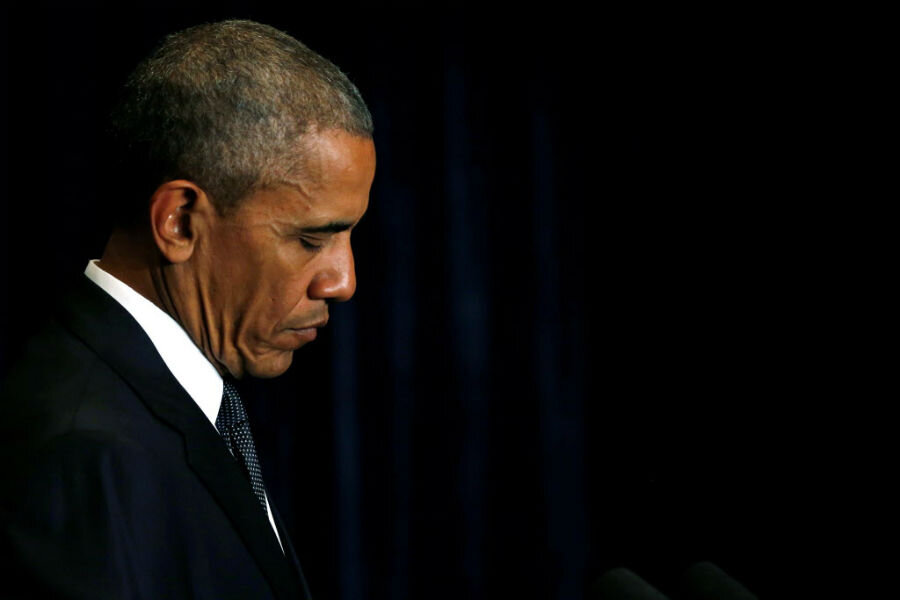Obama: Police must reduce 'appearance or reality of racial bias'
Loading...
Americans were repeatedly shaken this week by police-related violence, first with the deaths of two black men shot by officers in Louisiana and Minnesota, followed by the shooting of 12 officers in Dallas Thursday evening as they patrolled an ensuing protest. Five of the police officers have died. Two civilians were also shot.
President Obama has had to respond to these deaths and the public outcry against them from abroad, as he attends the last NATO summit of his presidency in Warsaw. By Friday morning, he had made two statements from Poland: the first after the death of Philando Castile in Falcon Heights, Minn., and the second after snipers opened fire on police in Dallas.
"When incidents like this occur, there's a big chunk of our citizenry that feels as if, because of the color of their skin, they are not being treated the same, and that hurts, and that should trouble all of us," Mr. Obama said after Mr. Castile's death. "This is not just a black issue, not just a Hispanic issue. This is an American issue that we all should care about."
But Obama moved past official statements later that day, taking to Facebook to discuss the police shootings of two black Americans this week, and the "symptomatic" challenges and racial disparities of the criminal justice system.
He first noted America's respect for "the vast majority of police officers," then made a strong appeal for change, saying "we can and must do better to institute the best practices that reduce the appearance or reality of racial bias in law enforcement."
Hours later, early on Friday, he once again addressed reporters about violence, this time mourning the lives lost in the Dallas sniper attack, which he called "vicious, calculated, and despicable."
"There's no possible justification for these kinds of attacks, or any violence against law enforcement," he said, vowing that "anyone involved in the senseless murders will be held fully accountable."
In the Facebook message posted Thursday, Obama highlighted his administration's most sweeping initiative to address police violence and the distrust that can characterize officer-resident relationships: the Task Force on 21st Century Policing, established through an executive order at the end of 2014.
The White House created the task force several months after the shooting of Michael Brown in Ferguson, Mo., which sparked a nationwide movement against systemic racism and police violence. The diverse coalition included directors of nonprofits and community-based organizations from around the nation, police chiefs, a criminal justice training professional, and a civil rights attorney.
Less than six months later, after hearing testimony and recommendations from across the country in public meetings and teleconferences, the task force released its recommendations.
The final report gave specific suggestions for training, education, and action within police departments. It stressed "building trust and legitimacy" within communities and urged law enforcement culture to have "a guardian – rather than a warrior – mindset." Some ways to do this, they said, include holding non-enforcement events, regularly surveying the community about trust, and ensuring a "broad range of diversity" on each police force.
The task force also urged departments to have "clear and comprehensive policies on the use of force" with emphasis on de-escalation.
"Police leaders nationwide see the need and are much more ready to take up this work than many realize," says Amy Crawford, deputy director of the National Network for Safe Communities, a project launched at John Jay College of Criminal Justice that works to reduce violence and improve police-community relationships in cities.
Her organization partners with police departments working "to build trust and legitimacy through trainings and interventions designed to enhance procedural justice, reduce implicit bias, and foster police-community reconciliation," Ms. Crawford said an emailed statement.
After the publication of the Task Force report, multiple police-related organizations, government agencies, and groups like National Network for Safe Communities got involved in supporting its mission. And the National Institute of Justice offered funding for local governments, non-governmental organizations, and research institutions to evaluate how the task force's recommendations were being put into effect. In 2016, the budget for this funding was $6.5 million.
The report itself, directed at the nation's 18,000 state and local law enforcement agencies, offered recommendations but did not require changes.
"When the federal government introduces different things for law enforcement, generally they can’t compel you to do it as long as you work within the guidelines of the federal law," explains Joseph Pollini, professor of criminal justice at John Jay College of Criminal Justice and retired lieutenant commander with the New York City police department.
However, Professor Pollini says, federal funding is one way the government incentivizes local police reform: funding for new programs and equipment can be increased if departments follow through on government recommendations – or decreased if they don't.
A summary of progress made by local police departments was released earlier this spring, highlighting action like the creation of community liaison officers, training sessions on the report for new recruits, and external systems for investigating police use of force.
Last month, the Community Oriented Policing Services office of the Department of Justice launched the "Advancing 21st Century Policing Initiative." Through the initiative, 15 police departments that have have been forerunners in incorporating the task force reforms will receive "hands-on assessments and technical assistance."
On Facebook, Obama said that citizens should urge their local police departments to adopt the solutions and reforms compiled by the task force to address racial injustice in their towns and cities, and "start restoring confidence that all people in this great nation are equal before the law."
"Rather than fall into a predictable pattern of division and political posturing, let's reflect on what we can do better," he added. "Let's come together as a nation, and keep faith with one another, in order to ensure a future where all of our children know that their lives matter."
This article has been updated to reflect new information.







